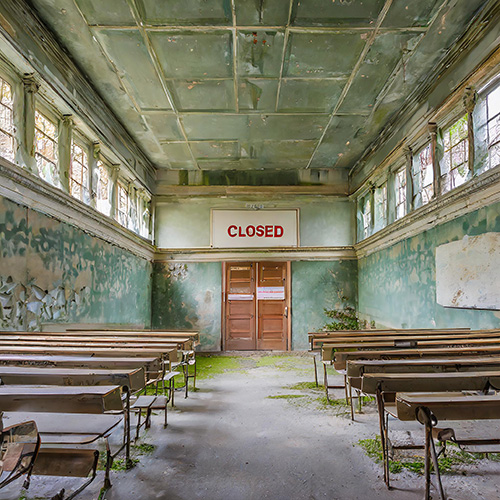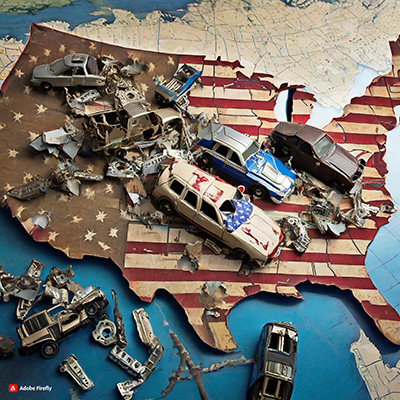Blog
The Value of California's Alcohol Tax Is the Value of Its Students
 Students of the California State University (CSU) system keep finding themselves pieces in Sacramento’s bleak budgetary chess. Last year, the legislature passed AB 840, which closed revenue holes by handing Big Alcohol carte blanche to market directly to underage undergraduates. To follow that up, California Governor Gavin Newsom clawed back $499 million from the system to balance the 2024 budget.
Students of the California State University (CSU) system keep finding themselves pieces in Sacramento’s bleak budgetary chess. Last year, the legislature passed AB 840, which closed revenue holes by handing Big Alcohol carte blanche to market directly to underage undergraduates. To follow that up, California Governor Gavin Newsom clawed back $499 million from the system to balance the 2024 budget.
The solution for both—one that neither kicks needed funding down the road, nor increases risks of academic failure and physical harm to students—comes from a simple, popular, yet apparently perversely unthinkable policy: ask the alcohol industry to pay the bare, fair minimum.
California’s taxes on alcohol producers are not a percentage of sales. Instead, they are set at a fixed dollar amount per quantity produced. This means that every year, it becomes cheaper and cheaper to be a producer in California, and that does not take into account federal alcohol tax cuts. Since California last established new rates in 1992, the alcohol excise tax has lost 55% of its value. In 2022, the California Department of Tax and Fee Administration reported approximately $429 million in revenue. However, had the excise tax value kept up with inflation, the expected take would have been $952 million—an additional $523 million just from normalizing the current tax rate.
That half a billion would fill the CSU budget hole, with a little change left over to fund programs and remove any ostensible need to sell student eyes to the industry. More importantly, it would modernize an alcohol tax that was last addressed during the first Bush administration.
This is more than just a pleasing symmetry. Not only are 40% of CSU students underage, but alcohol-related incidents are the leading causes of mortality for that age group. As of 2014, over 4,100 college-age young adults died annually of alcohol-related injury, including 2,614 from motor vehicle crashes. As for the other three acute causes of death, homicide and suicide are both strongly related to alcohol overconsumption, and alcohol greatly increases respiratory depression—and therefore overdose—from opioid use. On top of that, heavy and binge drinking patterns are associated with a number of negative academic consequences—and underage alcohol use can get students punished by the school itself.
There are a number of environmental interventions that can bring these numbers back down, but one of the most forthright ones are, again, alcohol taxes. By moderately raising the typical price of a drink, alcohol tax hikes affect people involved in the most dangerous drinking problems, particularly cash-strapped heavy drinkers—which perfectly describes the college students in the crosshairs of CSU’s bottle-pushing strategy.
This will not be the last time California is faced with brutal budgetary tradeoffs. Even a moderate hike in the alcohol excise tax can improve health in the short term, raise funds in the medium term, and let more compassionate heads in the legislature avoid mercenary lawmaking in the long term.
READ MORE about 2023’s AB 840
READ MORE about closing budget holes with alcohol taxes
TAKE ACTION to tell Gov. Newsom to include a cost-of-living alcohol excise tax increase in the May budget revise.
Alcohol Action Network Receives National Recognition
 The quietest people at the table would like to become the loudest ones in the legislative chamber.
The quietest people at the table would like to become the loudest ones in the legislative chamber.As its members become more deeply entrenched in the lasting harms and avalanche of deregulation that gathered during the pandemic, AAN's leaders have filled an ever more crucial place in the prevention landscape. In recognition of this, and their tireless efforts to coordinate academics and wonks to move out of their comfort zones, Dr. Haley and Ms. Tourre were deservedly formally recognized by APHA section leader Dr. Paul Gilbert.
The leadership awards were given to them at the American Public Health Association's annual conference, the flagship public health gathering in United States. The conference drew over 13,000 attendees. And while the ceremony was only in front of the Alcohol Tobacco and Other Drugs section, the audience contained advocates and scientists working across addiction medicine fields, because while alcohol harm mitigation remains AAN's explicit challenge, models that ensure that lifelong advocates are able to advance evidence-based, compassionate policy benefit everyone in the field.
Alcohol Justice and the California Alcohol Policy Alliance are proud participants in the Alcohol Action Network, and extend sincere congratulations and gratitude to Dr. Haley and Ms. Tourre.
READ MORE about the Alcohol Action Network
BAC to the Future? More States Join the Move to Reform
 Few consequences of alcohol consumption are as dramatic and tragic as motor vehicle collisions. As of 2021,13,384 people died in alcohol-related motor vehicle crashes in the United States, one every 39 minutes. And while the operatic image of an incoherent vilain speeding the wrong way on the highway remains the popular perception, in fact, over 2,200 crashes involve drivers with BACs under 0.08, the current legal limit. Even a moderate tweak to the BAC level would save lives, and has the potential for protective knock-on effects as well.
Few consequences of alcohol consumption are as dramatic and tragic as motor vehicle collisions. As of 2021,13,384 people died in alcohol-related motor vehicle crashes in the United States, one every 39 minutes. And while the operatic image of an incoherent vilain speeding the wrong way on the highway remains the popular perception, in fact, over 2,200 crashes involve drivers with BACs under 0.08, the current legal limit. Even a moderate tweak to the BAC level would save lives, and has the potential for protective knock-on effects as well.This is not a radical proposal. The majority of high- and middle-income countries issue dangerous driving citations for BACs below 0.08, with a nominal standard being 0.05 (though some nations, such as Sweden and Japan, set it even lower). And it is making inroads in the United States. In 2018, Utah became the first state to voluntarily enact the 0.05 BAC standard for driving under the influence charges. A subsequent analysis by the National Highway Traffic Safety Administration showed the initial years of the policy to be emphatic successes. Fatal crash rates declined 19.8% in Utah while the national rates declined 5.6%. Tourism and hospitality revenue, meanwhile, was unaffected.
Importantly, the number of stops for DUI remained unchanged. This stands to reason; absent an unlimited police force, total number of stops are dependent in large part on law enforcement capacity. However, in practice, police activity did not seem to be the same driver of increased road safety. Instead, Utah residents expressed greater awareness around alcohol consumption before driving, and greater anxiety around driving while intoxicated, after the bill passed.
This success has been seen by other states. California, of course, tried and failed to pass a Liam's Law in 2019, which would have put the largest state in the union in line with international best practices.* Other states continue the push. Bills to lower the DUI threshold were introduced in:
"New York was once a leader in combating drinking and driving, but now our policies are outdated,” [bill author Assm. Jo Anne Simon] said. "Over 100 countries have lowered their blood alcohol content policies to 0.05 or less because the evidence is clear that there is an increased crash rate at 0.05."
"It is very clear to me that drunk driving is impacting the safety of our communities, and it is time that we do something," said [bill sponsor Sen. John] Lovick during a public hearing on Monday. "Drunk driving is a choice. Drunk driving collisions are avoidable."
"Unfortunately we’re at a point where so many of us have been touched by this. We’ve lost somebody that we love due to an alcohol-related crash, and it’s just unacceptable at this point," Transportation Committee Chair Sen. Christine Cohen said. "We see the need to save lives across the state of Connecticut and there’s an opportunity to do that."
[Maui Coalition for Drug-Free Youth Director] Rick Collins closed his remarks with this message “Hawai‘i has the sixth highest alcohol-impaired traffic fatality rate in the nation. We can do without that distinction. And we can save hundreds of lives in the process.“
All faced industry opposition, largely couched as concern for small bars and restaurants. And all, unfortunately, have stalled in their respective legislatures. But the post-COVID fatal crash surges keep the issues fresh, as a large town's worth of U.S. residents are wiped out every year by alcohol-related collisions. It feels like a matter of time before the country comes in line with common sense, evidence-based international standards. Unfortunately, this passing time continues to take lives.
* Alcohol Justice continues to advocate for a reduced BAC threshold for DUI in California, in conjunction with enforcement reforms that would both increase road safety and reduce disparate impacts on racial and ethnic minority communities. Please contact us if for more information.
READ MORE about the fate of Liam's Law and similar 2019 efforts to reform BAC
READ MORE about alcohol-impaired driving in California
Worst Practices: New Report Sheds Light on CA Legislature's Reckless Deregulating
 It's not clear if violinists are well represented in Sacramento, but someone is certainly fiddling while the alcohol burns. Coming out of COVID-19 (if indeed we have), the alcohol-related death rate in the state has spiraled. As recently as 2015, around 11,000 Californians died from alcohol-involved causes yearly. In 2021, California Department of Public Health officials estimated the death toll as high as 19,335 annually. This raised an urgent question: has California's lawmaking exacerbated this trend, or helped keep it from being higher yet?
It's not clear if violinists are well represented in Sacramento, but someone is certainly fiddling while the alcohol burns. Coming out of COVID-19 (if indeed we have), the alcohol-related death rate in the state has spiraled. As recently as 2015, around 11,000 Californians died from alcohol-involved causes yearly. In 2021, California Department of Public Health officials estimated the death toll as high as 19,335 annually. This raised an urgent question: has California's lawmaking exacerbated this trend, or helped keep it from being higher yet?Alcohol Justice's new report, Circling the Barrel: the California 10-Year Review of Alcohol Policy, formally launched at the 2023 Global Alcohol Policy Conference, seeks to answer this question.
To acquire some insight in the priorities and decisionmaking of the California legislature, AJ researchers analyzed every piece of alcohol-related legislation over a 10 year period from 2013 to 2022. What they found will not surprise you; the legislature probably made alcohol harm worse, passing over twice as many harm-promoting bills than harm-preventing ones. The level of dogged determination to tear down protective alcohol policies, however, was extremely concerning; the sheer number of alcohol-related bills increased every session over the decade, and 44% passed, compared to an average 36% passage rate for all introduced bills.
To determine how proposed and/or passed bills would create or prevent harm, the researchers looked at these bills through a very specific lens. The World Health Organization compiles what they call the SAFER Technical Package, detailing five broad policy domains to reduce alcohol-related harms. The five domains are: price controls and taxes, marketing and advertising restrictions, restrictions on time and place of availability, access to screening and treatment, and prevention of intoxicated driving. Bills that increased harm were coded as "disaligned," while protective ones were considered "aligned." Every year, far more disaligned bills became law than aligned. Disaligned bills were most likely to affect availability, be it creating more licenses, extending last calls, or allowing alcohol to be distributed in new venues such as salons and barbershops. Nearly 1 in 4 of all alcohol-related bills, 90 total, fell in this category. Meanwhile, the protective bills were most likely to increase access to treatment--a valuable avenue for prevention, but by defintion too far downstream to prevent any harm.
"I hope this serves as a wakeup call," said lead author Carson Benowitz-Fredericks. "If we care about lives changed or lost from alcohol, we need to really let lawmakers know. We need them to know when their proposals are dangerous, and we need to know we rely on them to create lasting protections in the face of worsening harm."
The report is available for download on the Alcohol Justice webpage. Hard copies are available upon request.
READ MORE about industry influence in Sacramento.
READ MORE about 2023's batch of California alcohol legislation.
More Articles ...
Help us hold Big Alcohol accountable for the harm its products cause.
| GET ACTION ALERTS AND eNEWS |
STAY CONNECTED    |
CONTACT US 24 Belvedere St. San Rafael, CA 94901 415-456-5692 |
SUPPORT US Terms of Service & Privacy Policy |


